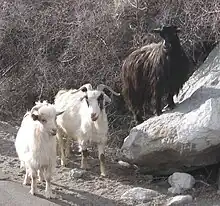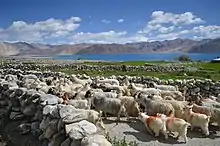 | |
| Conservation status | |
|---|---|
| Other names |
|
| Country of origin | India |
| Distribution | Ladakh |
| Use | |
| Traits | |
| Weight | |
| Height |
|
| Skin colour | white or light brown[3]: 369 |
| Wool colour | usually white, also black, brown or grey[3]: 369 |
| Horn status | horned in both sexes |
| |
.jpg.webp)

The Changthangi or Changpa is a breed of cashmere goat native to the high plateaus of Ladakh in northern India. It is closely associated with the nomadic Changpa people of the Changthang plateau. It may also be known as the Ladakh Pashmina or Kashmiri.
The intense cold of the region causes the goats to grow a thick undercoat, which is harvested to produce the fine pashmina grade of cashmere.[4] In the twenty-first century the quality of the pashmina is threatened by global climate change;[4] approximately three quarters of Indian pashmina production is from these goats.[5] They are also used as pack animals and for meat.[3]: 369
Description
These goats are generally domesticated and are reared by nomadic communities called the Changpa in the Changthang regions of Ladakh, including the Kharnak, Rupshu, Demchok/Skakjung and the Pangong Lake regions.[6]
The goats survive on grass in Ladakh, where temperatures plunge to as low as −20 °C (−4.00 °F).[7] These goats provide the wool for Kashmir's famous pashmina shawls. Shawls made from Pashmina wool are considered very fine, and are exported worldwide.
The Changthangi goats have revitalised the poor economy of Changthang, Ladakh where the wool production generates more than $8 million a year.[8]: 83
Noori, the world's first cloned Pashmina goat, was cloned at the Faculty of Veterinary Sciences and Animal Husbandry of the Sher-e-Kashmir University of Agricultural Sciences and Technology of Kashmir (SKUAST) in Shuhama, 25 km east of Srinagar, on 15 March 2012.
Characteristics
The Changthangi is a small goat, standing about 50 cm at the withers, and weighing on average approximately 20 kg. Both sexes are horned; the horns are large and twisted, and may reach a length of 55 cm.[3]: 369 The ears are small and upright.[8]: 81 The coat consists of an outer coat of long hair, and a thick undercoat of fine pashmina;[8]: 81 it is commonly white, but can also be black, brown or grey. The skin is white or pale brown.[3]: 369
See also
References
- ↑ Barbara Rischkowsky, D. Pilling (eds.) (2007). List of breeds documented in the Global Databank for Animal Genetic Resources, annex to The State of the World's Animal Genetic Resources for Food and Agriculture. Rome: Food and Agriculture Organization of the United Nations. ISBN 9789251057629. Accessed January 2017.
- 1 2 3 Breed data sheet: Changthangi / India (Goat). Domestic Animal Diversity Information System of the Food and Agriculture Organization of the United Nations. Accessed October 2021.
- 1 2 3 4 5 6 Valerie Porter, Lawrence Alderson, Stephen J.G. Hall, D. Phillip Sponenberg (2016). Mason's World Encyclopedia of Livestock Breeds and Breeding (sixth edition). Wallingford: CABI. ISBN 9781780647944.
- 1 2 Newey, Andrew (2 January 2020). "Pashmina goat herders struggle against climate change". CNN Style. Retrieved 2 January 2020.
- ↑ Sheikh I. Ishrat, Nigel P. Grigg, Nihal Jayamaha, Venkateswarlu Pulakanam (2018). Cashmere Industry: Value Chains and Sustainability. In: Chris K. Y. Lo, Jung Ha-Brookshire (editors) (2018). Sustainability in Luxury Fashion Business. Singapore: Springer. ISBN 9789811088780, pages 113–132.
- ↑ Misra, R. K.; Singh, B.; Jain, V. K. (1 February 1998). "Breed characteristics of Changthangi pashmina goat". Small Ruminant Research. 27 (2): 97–102. doi:10.1016/S0921-4488(97)00033-3. ISSN 0921-4488.
- ↑ "Kashmir Pashmina goats face death in icy Himalayas". Reuters. 6 February 2008. Retrieved 2 January 2020.
- 1 2 3 T.K. Bhattacharya, S.S. Misra, F.D. Sheikh, P. Kumar, A. Sharma (2004). Changthangi Goats: A rich source of pashmina production in Ladakh. Animal Genetic Resources Information. 35: 75–85. doi:10.1017/S1014233900001826. (subscription required).